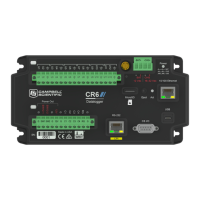6.6.1 VSPECT®
Measuring the resonant frequency by means of period averaging is the classic technique, but
Campbell Scientific has developed static and dynamic spectral-analysis techniques (VSPECT) that
produce superior noise rejection, higher resolution, diagnostic data, and, in the case of dynamic
VSPECT, measurements up to 333.3 Hz. For detailed information on VSPECT, see Vibrating Wire
Spectral Analysis Technology.
The data logger uses an audio ADC to capture vibrating wire signals on U terminals. Noise
frequencies may be sourced from harmonics of the natural frequency, electronic noise, or
harmonics of the electronic noise. For example, 50 Hz or 60 Hz noise from ac mains grid power
and associated harmonics are common noise sources. Noise frequencies may also originate from
mechanical obstruction of the taut wire, such as may be caused by a loose wire or when the wire
vibration is physically changed by sensor movement. VSPECT makes possible the separation of
the natural-resonant frequency from these other frequencies.
NOTE:
The FFT algorithm requires time for computation. Compile or download errors will occur if
the CRBasic program does not allow two seconds for the measurement of each sensor.
6.6.1.1 VSPECT diagnostics
The following diagnostics indicate the condition of a vibrating wire sensor:
l Decay ratio
l Signal-to-noise ratio
l Low signal strength amplitude warning
l Invalid voltage-supply warning
Decay ratio
“Decay” is the dampening of the wire vibration over time. The decay ratio is calculated as:
Decay Ratio = Ending Amplitude / Beginning Amplitude
Some sensors will decay very rapidly. A good practice is to characterize sensor decay and
amplitude when a sensor is new; so, the health of the sensor can be monitored over time.
Signal-to-noise ratio
The signal-to-noise ratio is calculated as:
Signal-to-Noise Ratio = Response Amplitude / Noise Amplitude
6. Measurements 86

